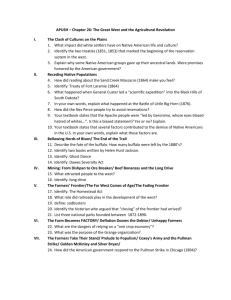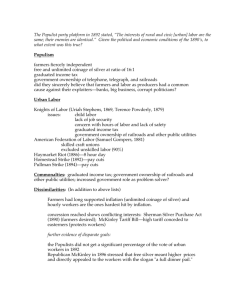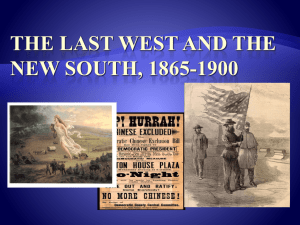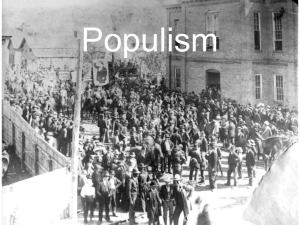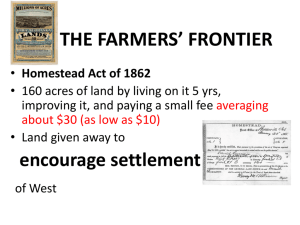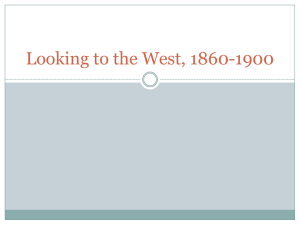Chapter 26 Notes
advertisement
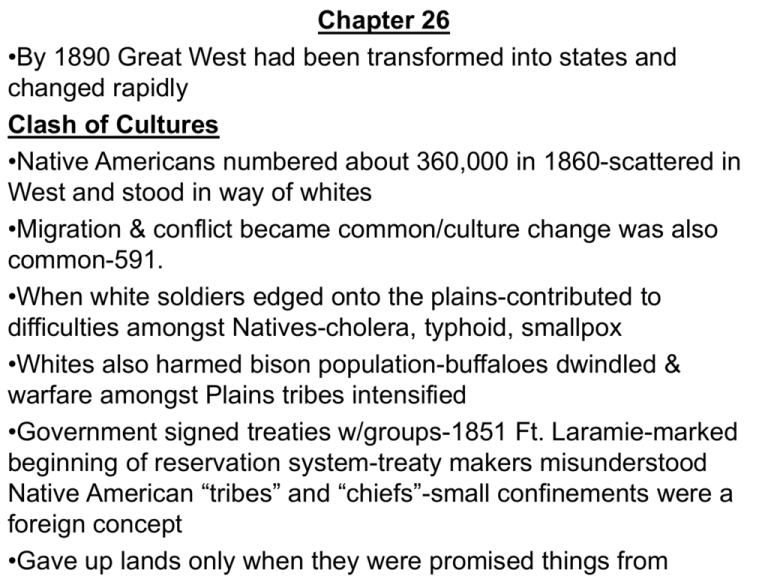
Chapter 26 •By 1890 Great West had been transformed into states and changed rapidly Clash of Cultures •Native Americans numbered about 360,000 in 1860-scattered in West and stood in way of whites •Migration & conflict became common/culture change was also common-591. •When white soldiers edged onto the plains-contributed to difficulties amongst Natives-cholera, typhoid, smallpox •Whites also harmed bison population-buffaloes dwindled & warfare amongst Plains tribes intensified •Government signed treaties w/groups-1851 Ft. Laramie-marked beginning of reservation system-treaty makers misunderstood Native American “tribes” and “chiefs”-small confinements were a foreign concept •Gave up lands only when they were promised things from Receding Native Populations • Savage clashes in West-Sand Creek, Col-1864(Chivington massacred 400 Natives) • Sioux party massacred 81 soldiers in Montana-cylce continued • Treaty of 1868 of Fort Laramie-government abandoned Bozeman Trail-”Great Sioux Reservation”-however in 1874 Custer led a mission in Black Hills of S. Dakota & announced he had discovered gold-gold seekers swarmed in forcing Sioux to take to violent means-led by Sitting Bull • Custer and 7th Cavalry, 1/2 immigrants attacked 2,500 warriors at “Little Big Horn” in Montana-Custer was demolished along with 264 officers and men-”battle” or “massacre”? • One band of Nez Perce in N’eastern Oregon pushed into fighting-1877 Chief Joseph surrendered his band of 700 after a 1,700 mile trek-Joseph hoped to meet up with Sitting Bull in Canada after Little Big Horn-Thought they would be returned to ancestral lands in Idaho-taken to Kansas where 40 % died • Apaches were tough to subdue(led by Geronimo)-pushed down & had farming success in Oklahoma • Fighting finally ended w/Reservations • “Taming” caused by many factors:RR in west, transport troops & settler, diseases, gunpowder, & extinction of buffalo Bellowing Herds of Bison • For the Plains Indians buffalo provided life • When Civil War ended, 15 million grazed-as RR came population dropped-by 1885 wasteful killing left fewer than 1,000 End of the Trail • By the 1880s much uneasiness about the plight of NativeAmericans-Helen Hunt Jackson-A Century of Dishonor- brought much sympathy • Debate intensified-some wanted assimilation & others wanted simply to contain and punish • Missionaries sometimes punished Native Americans into adopting Christianity • 1884 Federal Government outlawed the Sun Dance-Ghost Dance stamped out with the Battle of Wounded Knee in 1890200 Native Americans killed • Dawes Severalty Act of 1887-dissolved many tribes, wiped our tribal ownership of land & set up individual family heads w/ 160 free acres-If acted well they would get full citizenship in 25 years-Full Citizenship came in 1924 • Reservation land not allotted to Native Americans under the Dawes Severalty Act sold to whites and RR w/ proceeds used by the government to “civilize” the Native Americans • 1879 the Carlisle Indian School in Pennsylvania took children from homes-1890s schools were extended and women were sent in to teach Native American women hygiene and chastity • Dawes Act struck at tribes & tried to make rugged individualists • By 1900 50% of 156 million acres held were lost • Forced assimilation remained the government policy for nearly 1/2 century until Indian New Deal of 1934 reversed individualistic approach & tried to restore tribal basis • In 1887 only 243,000 Native Americans yet by 2000-1.5 million Mining • Westward push of miners-1858-gold rush in the Rockies • “59ers” pushed into Nevada-Comstock Lode • Idaho, Montana, & others experienced gold rushers as well • “Helldorados”-vigilante justice-ghost towns • Once loose surface gold was dug, ore breaking machines brought in-Big Business entered • Small miner died out yet important-Westward expansionwomen won equality in roughneck frontier-right to vote • Precious metals helped to finance the Civil War, building of RR, intensified white-Native American conflict, threw silver into politics and added to literature Beef and the Long Drive • After Civil War-in came the millions of cattle-w/ RR cattle could be shipped & meatpacking emerged-stockyards of Chicago & K.C. shipped to East • “Long Drive”-cowboys drove herds to RR terminal-herds grazed on government grass-towns grew(Dodge City, Abilene, Cheyenne)-order maintained by Marshals • As long as the grass grew-profits came- except for Native Americans,stampedes, and cattle fever-4 million driven from 1866-1888 • RR ruined the Long Drive-more homesteaders & sheepherders came and ruined by land ownership as well as 1886-87 freezing winters and overexpansion • Cattle raisers fenced in and made meatier animals • Heyday of the American cowboy-folklore Farmer’s Frontier • Grazing land became farmland-Homestead Act of 1862-160 acres for living on land for 5 years and improving it-paid $30 • Given away to fill empty space-family farm was the “backbone of democracy”-1/2 million tried yet 5 times more bought land from RR, land companies, and states • Homestead Act-Cruel Hoax? • More land ended up in land grabber’s hands-profit from timber, minerals, or oil-improve land? • RR made out well-marketing crops • Many felt plains would not grow crops-once the sod was broken much success followed • Wheat prices fell in 1870s, settlers pushed further west beyond 100th meridian to east-well watered and semiarid • Many lost $ in attempts to grow west of Kansas-No Rain! • Dry farming used yet attributed to the Dust Bowl • New crops developed(wheat & sorghum) • Irrigation projects created a blossoming population • Columbia, Missouri and Colorado Rivers tapped into-engineers added more growth than any other actions Far West Comes of Age • Western growth-Colorado, Dakotas, Montana, Washington, Idaho, Wyoming, later Utah-only Oklahoma, NM, & Arizona remained of contiguous • Government opened up free land in Oklahoma-”Sooners and Boomers” Fading Frontier • By 1890 Frontier was no longer discernible • Frederick Jackson Turner-thesis on significance of the American frontier! • Frontier was filling-phase ending led to problems-no longer footloose, safety valve of moving west was not accurate • Free acreage did attract some immigrant farmers and lure workers leaving kept wages up-Real safety valve was the western cities-more urbanized • US History cannot be understood without westward movementlast and distinct chapter • 1. Native American struggle 2. Anglo-Hispanic culture 3. Pacific to Asia 4. Environmental issues 5. Large government role unparalleled 6. Myths of West Farm and Factory • Farms-once subsistence turned to cash crops-used profits to buy goods • Large scale farmers in Mississippi Valley were businesspeopletied to the banking, RR, and manufacturing • Had to buy expensive machines-speed increased w/ combinespushed smaller farmers off the land-Agribusiness • California was a state of plantations & estates-fruit and veg. crops flourished w/ cheap foreign labor Deflation • One crop system-corn-wheat-price dropped in 1880s-fiercely competitive business-world market determined prices-if other world market flourished prices fell • Borrowed $ and price per bushel limited • Problems w/static $ supply-low in comparison to growth • Farmers functioned year after year in a loss-better production yet less $ w/suplus • More and more lost farms by 1890 • 8-40% mortgage rates-mostly by eastern agents • Farm tenancy rather than ownership spread-by 1880 1/4 of farms operated by tenants-New industry yet old serfdom Unhappy Farmers • Problems-grasshoppers, boll weevil, floods, droughts • Gouged by government-overassessed & paid heavy local taxes • High protective tariffs helped wealthy easterners • Had to sell in world market while buying goods in a protected market • At the mercy of corporations and processors • RR had growers in its grip-freight rates were too high • Farmers made of 1/2 of population in 1890 yet unorganizedindividual and independent by nature-slow to organize yet did lead a political uprising Farmers Take a Stand • Farmers had organized to push greenbacks • 1867-National Grange of the Patrons of Husbandry-enhance the lives of isolated farmers-gathering, secrecy, & hierarchy • By 1875 800,000 members-goals ranged from self improvement to eventually the establishment coop stores, elevators, warehouses, and attempted to manufacture harvest machinery • Went into politics in Midwest-strove for regulation-various Granger Laws drawn yet eventually failed & so too did Grangers • Found vent in Greenback Party-ran James Weaver for president in 1880-no real success Prelude to Populism • Farmer’s Alliance (1870s)-came together to combat corporation’s grip through coop buying-by 1890-more than 1 million • Ignored tenant farmers excluded blacks-1/2 of agriculture population in South-1880 Colored Farmers National Alliance formed • People’s Party-1890s-Populists-Goals: Nationalizing RR, telephone, graduated income, subtreasury, free unlimited coinage of silver • Had to be taken seriously-Dem/Repubs had pay attention • 1892 ushered members into Congress Coxey’s Army and Pullman Strike • Panic of 1893 & depression strengthened Populists • Jacob Coxey led march to Washington demanding government public works programs-arrested for walking on grass • Chicago-Pullman Strike of 1894-Eugene V. Debs-labor leader helped organize American RR Union-150,000 strong • Pullman Palace Car Company-model town near Chicago-hit hard-unemployed, salaries cut-wages remained-workers struckAF of L did not support-Gov. Altgeld felt things were OK yet Att. Gen. Richard Olney sent federal troops-interfering w/US mail • Crushed Pullman Strikes-Debs put in prison-Socialism? • Justice? Gold McKinley/Silver Bryan • Election of 1896-Employers vs. Workers-Gold vs. Silver • Republican-McKinley-Ohio-big business & politics(Hanna)supported gold and soft on silver and supported high tariff • Democrat-William Jennings Bryan of Nebraska-”Cross of Gold” demanded silver Class Conflict • Bryan made silver the issue w/ his vigorous campaign • Eastern conservatives attacked Bryan/Hanna raised millions($16 million for Republicans) • Intimidation tactics-McKinley won big-Areas of strength? • Factory worker would not vote for inflation • New era in American politics, East v. West, Prosperity v. PoorVictory to big business, big cities, middle class values, financial conservatism • Future politics lay in cities not farms • Long reign of Republicans-diminishing voters, weakening party organizations, fading issue of $-”Fourth Party System”? • Issues of Industrial Regulation & Welfare of Labor dominated Republicans • McKinley was a “safe” politician • Shied away from reform-business unfettered & trusts grew • Wilson-Gorman Tariff • Dingley Tariff passed-higher-46.5% • Prosperity returned & Republicans took credit • Gold Standard of 1900 established-more discoveries-inflation came and silver and the money issue faded
